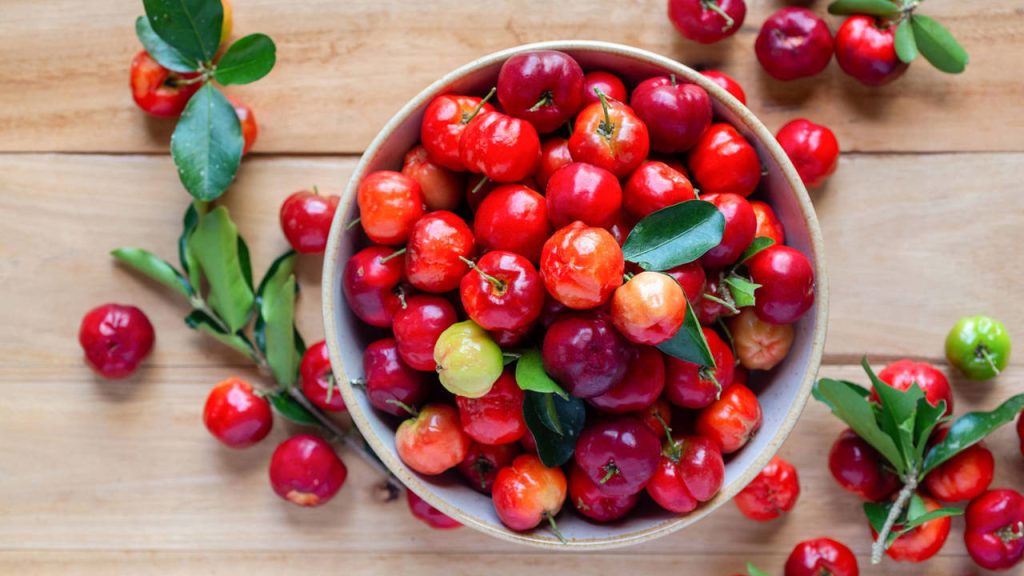Acerola is one of the richest fruits in vitamin C and, although it is most common to take it in supplement form, it is also dehydrated and you can grow it at home.

- What is acerola
- Properties of acerola
- What is acerola for?
- How acerola is taken
- Precautions and contraindications
- Growing acerola at home
- Recipes with acerola
- Acerola and acerola are not the same
Acerola, a cherry-like fruit not to be confused with acerola, has recently become famous for being an extraordinary source of vitamin C, making it a good natural resource for preventing infections and reducing fatigue.
WHAT IS ACEROLA
The acerola Malpighia glabra (synonymous with Malpighia emarginata DC.) is a tropical shrub, measuring between 3 and 5 meters tall, with oval, pointed leaves and beautiful pink flowers, gathered in lax panicles.
The famous fruit of acerola, the edible and medicinal part of this shrub, is a fleshy drupe, bright red when ripe. By its appearance it can remind a small cherry and has a somewhat acidic, but pleasant taste.
Acerola is native to Central and South America, from Mexico to Colombia, and has been introduced in other countries in the area such as Venezuela, Brazil or Peru, but also in other tropical areas of the world, in Africa and Asia. It is known by other names, such as cerecita or semeruco, and has been traditionally used by native populations as a remedy against dysentery and general weakness.
The presence of acerola, whether fresh or dehydrated, in Europe is relatively recent, especially in the form of a vitamin supplement.
PROPERTIES OF ACEROLA
Acerola is one of the richest fruits in vitamin C: it contains up to 2 grams of this essential nutrient per 100 g, which is equivalent to about 20 or 30 times what a citrus fruit like orange gives us, or a fruit as rich in vitamin C as kiwi.
It also contains high doses of B vitamins, such as B1, B2 and B6, mineral salts (calcium, iron, magnesium, phosphorus and potassium), carotenoids in its pigments, flavonoids, sugars and polyphenols.
It is attributed vitamin, remineralizing, antioxidant, anti-inflammatory, defatigant, antiseptic, antimicrobial, astringent, digestive and nutritive properties.
WHAT IS ACEROLA FOR?
Thanks to this nutritional composition, and especially its richness in vitamin C, acerola provides great health benefits.
Both fresh and dehydrated fruit, but especially supplements with acerola, are recommended to combat states of weakness, fatigue, in periods of convalescence or as support in states of stress and mild depression.
It is also a good natural resource to increase defenses, which can come in handy to prevent or deal with common infections. It is indicated to prevent and relieve colds, flu processes and other viral or bacterial respiratory infections.
In addition, it promotes good digestion and helps relieve gastrointestinal spasms and stomach upset. In fact, it is a great fruit to combat diarrhea, as it has a high astringent power. Acerola is indicated to treat diarrhea, colic, indigestion or mild poisoning.
As an astringent, topically, it is used in the form of a cream or ointment to treat skin impurities, eczema and boils.
HOW ACEROLA IS TAKEN
The acerola can be purchased in different presentations. There is a great offer online.
- Fresh fruit, in packs or in bulk, in specialized establishments and organic and vegan products.
- Dehydrated fruit.
- In natural juice.
- In the form of vitamin supplements.
- In tincture
- In powders to dissolve in water or juice.
- In chewable tablets.
- In capsules.
PRECAUTIONS AND CONTRAINDICATIONS
If you take acerola in the form of a vitamin supplement, consult your GP before deciding to start treatment. Avoid prolonged treatments.
Excessive doses of acerola could lead to cramping, intestinal spasms, diarrhea, nausea, vomiting and malaise. It is therefore possible to consume it responsibly and with common sense.
GROWING ACEROLA AT HOME
You can buy fresh acerola and in bulk in some greengrocers, especially organic products, although their presence is still limited. It is easier to find it in the form of chewable tablets, in packets of dehydrated acerolas and in juices, also online.
However, it is possible to purchase acerola seeds or seedlings in gardening or online. Acerola can be planted in large pots or better in plots of your garden, to be able to have a small supply of this vitamin fruit.
It needs to be sheltered from drafts, in a well-drained soil and generous irrigation, because we are before a tropical plant, in need of rain constantly.
RECIPES WITH ACEROLA
Acerola fruits give a lot of play in the kitchen. With them you can make tasty juices, with a somewhat acidic touch. It is necessary to remove its seeds first.
You can prepare an acerola juice, for example, acerola with lemon and kiwi.
Acerola jam is made with 1 kg of these cherries, 500 g of sugar and a glass of orange or lemon juice. It is cooked for half an hour, until it takes on a gelatinous texture. It is passed to a jar with a lid and, once cold, it is kept in the fridge.
Other acerola recipe ideas include:
- Acerola compote
- Acerola cake with cornmeal and orange juice
- Acerola, strawberry and orange mousse
- Acerola soda
- Acerola liquor
- Acerola and chocolate chocolates
ACEROLA AND ACEROLO ARE NOT THE SAME
Acerola should not be confused with acerola Crataegus azolos, a shrub close to hawthorn.
Acerola is native to the Middle East, but is frequently grown in parks and gardens, and its berries, also red, also stand out for their high vitamin power, especially in B vitamins and vitamin C.
Vitamin supplements are also produced from acerola.








